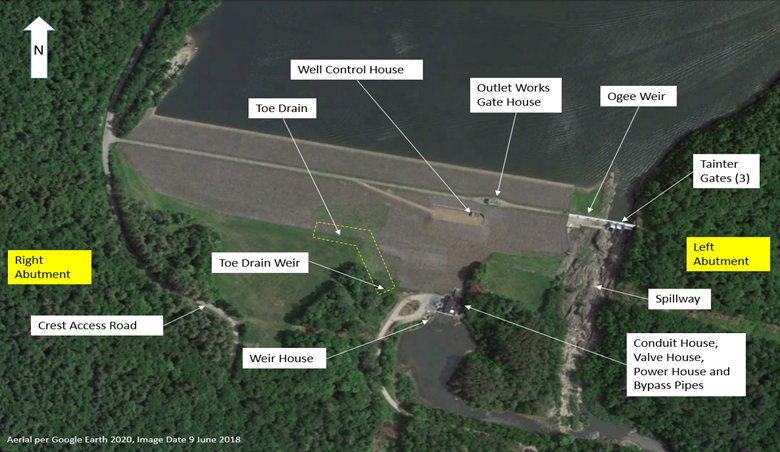Updated: November 2024
Project Purpose & Benefits:
This project aims to restore full flood control functionality to the dam by addressing structurally deficient radial arm flood gates (Tainter gates) and degraded concrete at the spillway at the eastern end of Waterbury Dam. The Vermont DEC Dam Safety Program is working with the New England District (NED) of the United States Army Corps of Engineers on the evaluation and design of this project, which is funded with Federal and State dollars.
Benefits of the project include:
- Allow full flood control capability of the dam to be realized while reducing risks of flooding in downstream communities.
- Improve water quality in Waterbury Reservoir and the Little River by eliminating the need for seasonal drawdowns in water level.
- Improved Operation and Maintenance of the dam.
- Improved public safety.
- Continued support for existing hydropower and recreational uses of Waterbury Reservoir.

Project Timeline:
Risk Assessment – Completed
Lake Champlain Basin Program, $700k
- Holistic evaluation of complete dam including site visits, reviewing existing plans, records, and data.
- Identification of Potential Failure Modes (PFMs) of the dam and downstream consequences of dam failure.
- Inform future project study and design to reduce dam safety risks.
Dam Safety Modification Study (Underway-Spring 2025)
Section 1177 Water Infrastructure Improvements for the Nation Act (WIIN), $3M
-
Additional study necessary to better evaluate the risk driving PFMs identified in the Risk Assessment.
-
Quantitative risk assessment of key risk-driving PFMs.
-
Field data collection, including structural inspections of the Tainter Gates, geologic exploration and mapping of spillway bedrock, collection of representative bedrock and concrete samples from the spillway, laboratory testing, and updated analyses.
-
Identification of rehabilitation alternatives.
-
A draft of the Environmental Assessment (EA) has been prepared to evaluate potential environmental and cultural impacts of the proposed project (anticipated release in November or December 2024).
Interim Risk Reduction Measures, completed Spring 2024, ~$785,000
To ensure safe and reliable operation of the spillway flood gates, the following temporary risk reduction measures were implemented and are to remain in place until the Spillway Project is complete.
Strut Arm Reinforcement
To allow the strut arms on Gate 2 to safely carry excess stress from Trunnion friction, steel plates were welded to the strut arms to allow for safe and reliable operation.
Heli-lift to Aid in Underpinning the Spillway Bridge
To address overstressing issues in the spillway bridge, top and bottom side steel beams were installed to sandwich the concrete bridge deck. Due to remote access challenges, beams were delivered to their final location via helicopter.




Design & Permitting (Spring 2025-Spring 2027)
Section 1177 WIIN, ~$5M
It is anticipated that design will include performing additional subsurface explorations of the concrete and bedrock in the spillway, development of construction access plans, as well as engineering design for the flood gates, concrete rehabilitation, spillway bridge, and concrete apron. Once that is complete, biddable plans and specifications will be developed for the work for the work. Those plans will also be used to acquire dam safety and environmental permits for the project.
Dam Tunnel and Penstock Inspection Project (Ongoing - Fall 2025)
This project is focused on determining the condition and identifying maintenance repair for the gate system and associated tunnel and penstocks that convey flow through the dam for hydropower use and general passage/bypass. The project includes the following:
- Structural assessment of the Head Gate (also known as Broome Gate) located in the gatehouse on the dam crest that can be used to dewater the tunnel and penstocks.
- Dive Team cleaning and inspection of the Head Gate guides and sealing surfaces.
- Cleaning/removal of accumulated sediment and debris in the tunnels and penstocks to permit a detailed inspection.
- Inspection and non-destructive testing of the penstock and tunnel.
- Engineering analyses of the penstock and tunnels.
- Evaluation of the condition of the two valves on the 48-inch diameter bypass penstock.
- Identification of any maintenance or repair needs.
This work is important as these systems will be used solely during the spillway project to convey flows through the dam.
Construction (~Spring 2027 to 2029)- Pending Available Funding
Section 1177 WIIN, ~$80.5 (current Draft Class 3 Cost Estimate). The project is anticipated to include the following items (see figure above):
- Take measures to provide commensurate flood protection during the project with the spillway out of service as with the spillway in full operation. This will require a temporary water level drawdown.
- Install construction access roads, pads, and laydown areas at the site.
- Replace Flood Gates 1 and 2 with new gates.
- Replace Gate 2 left trunnion pin and potentially additional trunnion pins.
- Rehabilitate Gate 3.
- Remove the existing spillway bridge that does not have adequate capacity and replace it with a new spillway bridge.
- Remove the gate hoist mechanism and replace it with modern equipment.
- Repair degraded concrete surfaces.
- Install concrete apron downstream of gated spillways to protect against continuing spillway bedrock erosion.
Additional Resources:
Waterbury Dam Spillway Refurbishment Project Public Information Meeting
